Model-Based Fault Diagnosis of an Anti-Lock Braking System via Structural Analysis
Abstract
:1. Introduction
2. Structure Analysis Based Fault Detection and Identification for ABS
2.1. The Critical Faults Analysis for ABS
2.2. Fault Modelling of ABS
2.3. Fault Detectability Analysis and Fault Isolability Analysis by SA
2.4. Finding Minimal Structural Over-Determined(MSO) Sets
2.5. Residual Design for FDI System
3. Design and Validation of FDI System
3.1. FDI System Design
3.2. Residual Testing
4. Experimental Validation
4.1. Experimental Set-Up
4.2. FDI System Testing
5. Conclusions
Author Contributions
Funding
Acknowledgments
Conflicts of Interest
References
- Palin, R.; Ward, D.; Habli, I.; Rivett, R. ISO 26262 safety cases: Compliance and assurance. In Proceedings of the 6th IET International Conference on System Safety 2011, Birmingham, UK, 20–22 September 2011; pp. 1–6. [Google Scholar]
- Gao, Z.; Cecati, C.; Ding, S.X. A survey of fault diagnosis and fault-tolerant techniques—Part I: Fault diagnosis with model-based and signal-based approaches. IEEE Trans. Ind. Electron. 2015, 62, 3757–3767. [Google Scholar] [CrossRef]
- Cecati, C. A survey of fault diagnosis and fault-tolerant techniques—Part II: Fault diagnosis with knowledge-based and hybrid/active approaches. IEEE Trans. Ind. Electron. 2015, 62, 3768–3774. [Google Scholar]
- Patton, R.; Chen, J. A review of parity space approaches to fault diagnosis. IFAC Proc. Vol. 1991, 24, 65–81. [Google Scholar] [CrossRef]
- Frank, P.M.; Ding, X. Survey of robust residual generation and evaluation methods in observer-based fault detection systems. J. Process Control 1997, 7, 403–424. [Google Scholar] [CrossRef]
- Krishnaswami, V.; Luh, G.; Rizzoni, G. Nonlinear parity equation based residual generation for diagnosis of automotive engine faults. Control Eng. Pract. 1995, 3, 1385–1392. [Google Scholar] [CrossRef]
- Agarwal, D.; Singh, C.K. Model-Based Fault Detection on Modern Automotive Engines. In Advanced Engine Diagnostics; Springer: Berlin, Germany, 2019; pp. 167–204. [Google Scholar]
- Luo, J.; Pattipati, K.R.; Qiao, L.; Chigusa, S. Model-based prognostic techniques applied to a suspension system. IEEE Trans. Syst. Man Cybern. Part A Syst. Hum. 2008, 38, 1156–1168. [Google Scholar]
- Lee, H. Analysis of model-based sensor fault diagnosis with application to a motor-driven power steering system. Proc. Inst. Mech. Eng. Part D J. Automob. Eng. 2011, 225, 1317–1333. [Google Scholar] [CrossRef]
- Zhang, K.; Jiang, B.; Shi, P.; Cocquempot, V. Observer-Based Fault Estimation Techniques; Springer: Berlin, Germany, 2018. [Google Scholar]
- El Hajjaji, A.; Chadli, M.; Oudghiri, M.; Pages, O. Observer-based robust fuzzy control for vehicle lateral dynamics. In Proceedings of the American Control Conference, Minneapolis, MN, USA, 14–16 June 2006; pp. 4664–4669. [Google Scholar]
- You, S.-H.; Cho, Y.M.; Hahn, J.-O. Model-based fault detection and isolation in automotive yaw moment control system. Int. J. Automot. Technol. 2017, 18, 405–416. [Google Scholar] [CrossRef]
- Chen, F.; Jiang, R.; Zhang, K.; Jiang, B.; Tao, G. Robust backstepping sliding-mode control and observer-based fault estimation for a quadrotor UAV. IEEE Trans. Ind. Electron. 2016, 63, 5044–5056. [Google Scholar] [CrossRef]
- Hongjun, M.; Liu, Y.; Li, T.; Yang, G.-H. Nonlinear High-Gain Observer-Based Diagnosis and Compensation for Actuators and Sensors Faults in a Quadrotor Unmanned Aerial Vehicle. IEEE Trans. Ind. Inform. 2018. [Google Scholar] [CrossRef]
- Kommuri, S.K.; Defoort, M.; Karimi, H.R.; Veluvolu, K.C. A robust observer-based sensor fault-tolerant control for PMSM in electric vehicles. IEEE Trans. Ind. Electron. 2016, 63, 7671–7681. [Google Scholar] [CrossRef]
- Choi, C.; Lee, K.; Lee, W. Observer-based phase-shift fault detection using adaptive threshold for rotor position sensor of permanent-magnet synchronous machine drives in electromechanical brake. IEEE Trans. Ind. Electron. 2015, 62, 1964–1974. [Google Scholar] [CrossRef]
- Wang, Y.; Tian, J.; Chen, Z.; Liu, X. Model based insulation fault diagnosis for lithium-ion battery pack in electric vehicles. Measurement 2019, 131, 443–451. [Google Scholar] [CrossRef]
- Merzouki, R.; Djeziri, M.A.; Ould-Bouamama, B. Intelligent monitoring of electric vehicle. In Proceedings of the IEEE/ASME International Conference on Advanced Intelligent Mechatronics, Singapore, 14–17 July 2009; pp. 797–804. [Google Scholar]
- Luo, J.; Namburu, M.; Pattipati, K.R.; Qiao, L.; Chigusa, S. Integrated model-based and data-driven diagnosis of automotive antilock braking systems. IEEE Trans. Syst. Man Cybern. Part A Syst. Hum. 2010, 40, 321–336. [Google Scholar] [CrossRef]
- Du, B.; Wu, S.; Han, S.; Cui, S. Interturn fault diagnosis strategy for interior permanent-magnet synchronous motor of electric vehicles based on digital signal processor. IEEE Trans. Ind. Electron. 2016, 63, 1694–1706. [Google Scholar] [CrossRef]
- Jedlinski, L.; Caban, J.; Krzywonos, L.; Wierzbicki, S.; Brumercik, F. Application of vibration signal in the diagnosis of IC engine valve clearance. J. Vibroeng. 2015, 17, 175–187. [Google Scholar]
- Puchalski, A. A technique for the vibration signal analysis in vehicle diagnostics. Mech. Syst. Signal Process. 2015, 56–57, 173–180. [Google Scholar] [CrossRef]
- Indira, V.; Vasanthakumari, R.; Jegadeeshwaran, R.; Sugumaran, V. Determination of minimum sample size for fault diagnosis of automobile hydraulic brake system using power analysis. Eng. Sci. Technol. Int. J. 2015, 18, 59–69. [Google Scholar] [CrossRef]
- Wong, P.K.; Zhong, J.H.; Yang, Z.X.; Vong, C.M. Sparse Bayesian extreme learning committee machine for engine simultaneous fault diagnosis. Neurocomputing 2016, 174, 331–343. [Google Scholar] [CrossRef]
- Zheng, X.; Yang, S.; Zhou, A.; Shi, H. A Knowledge-Based Diagnosis System for Automobile Engines. In Proceedings of the IEEE International Conference on Systems, Man, and Cybernetics, Beijing, China, 8–12 August 1988; pp. 1042–1047. [Google Scholar]
- Jegadeeshwaran, R.; Sugumaran, V. Brake fault diagnosis using Clonal Selection Classification Algorithm (CSCA)—A statistical learning approach. Eng. Sci. Technol. Int. J. 2015, 18, 14–23. [Google Scholar] [CrossRef]
- Li, X.Y.; Wang, Z.P. A novel fault diagnosis method for lithium-Ion battery packs of electric vehicles. Measurement 2018, 116, 402–411. [Google Scholar] [CrossRef]
- Tan, C.F.; Juffrizal, K.; Khalil, S.N.; Nidzamuddin, M.Y. Knowledge-based fault diagnosis system for refuse collection vehicle. In Proceedings of the International Conference on Mathematics, Penang, Malaysia, 28–30 May 2014; pp. 1292–1296. [Google Scholar]
- Isermann, R.; Schwarte, A. Fault Diagnosis of a Turbocharged Diesel Engine with Dynamic Neural Networks and Parity Methods. Intell. Syst. Control 2004, 446–451. [Google Scholar]
- Kimmich, F.; Schwarte, A.; Isermann, R. Fault detection for modern Diesel engines using signal-and process model-based methods. Control Eng. Pract. 2005, 13, 189–203. [Google Scholar] [CrossRef]
- Svärd, C.; Nyberg, M.; Frisk, E.; Krysander, M. Automotive engine FDI by application of an automated model-based and data-driven design methodology. Control Eng. Pract. 2013, 21, 455–472. [Google Scholar] [CrossRef] [Green Version]
- Tousi, M.M.; Aghdam, A.G.; Khorasani, K. A hybrid fault diagnosis and recovery for a team of unmanned vehicles. In Proceedings of the IEEE International Conference on System of Systems Engineering, Singapore, 2–4 June 2008; pp. 1–6. [Google Scholar]
- Khorasani, K. A hybrid fault detection and isolation strategy for a team of cooperating unmanned vehicles. Int. J. Control 2015, 88, 90–103. [Google Scholar]
- Selvanayaki, K.S.; SomaSundaram, R. Hybrid Approach for Detection and Recognition of Vehicles. J. Comput. Sci. 2015, 11, 304–314. [Google Scholar] [CrossRef]
- Espinoza-Trejo, D.R.; Campos-Delgado, D.U. Active fault tolerant scheme for variable speed drives under actuator and sensor faults. In Proceedings of the 2008 IEEE International Conference on Control Applications, San Antonio, TX, USA, 3–5 September 2008; pp. 474–479. [Google Scholar]
- Chamseddine, A.; Theilliol, D.; Zhang, Y.M.; Join, C.; Rabbath, C.A. Active fault-tolerant control system design with trajectory re-planning against actuator faults and saturation: Application to a quadrotor unmanned aerial vehicle. Int. J. Adapt. Control Signal Process. 2015, 29, 1–23. [Google Scholar] [CrossRef]
- Wang, R.R.; Wang, J.M. Fault-Tolerant Control with Active Fault Diagnosis for Four-Wheel Independently Driven Electric Ground Vehicles. IEEE Trans. Veh. Technol. 2011, 60, 4276–4287. [Google Scholar] [CrossRef]
- Sachenbacher, M.; Struss, P. Fault isolation in the hydraulic circuit of an ABS: A real-world reference problem for diagnosis. In Proceedings of the Working Notes of the 8th International Workshop on the Principles of Diagnosis (DX-97), Mont-Saint-Michel, France, 15–18 September 1997; pp. 113–119. [Google Scholar]
- Struss, P.; Malik, A.; Sachenbacher, M. Qualitative modeling is the key to automated diagnosis. IFAC Proc. Vol. 1996, 29, 6365–6370. [Google Scholar] [CrossRef]
- Pisu, P.; Soliman, A.; Rizzoni, G. Vehicle Chassis Monitoring System. IFAC Proc. Vol. 2001, 34, 271–276. [Google Scholar] [CrossRef]
- Börner, M.; Straky, H.; Weispfenning, T.; Isermann, R. Model based fault detection of vehicle suspension and hydraulic brake systems. Mechatronics 2002, 12, 999–1010. [Google Scholar] [CrossRef]
- Zahedi, E.; Gharaveisi, A. Fault detection and isolation of Anti-lock Braking System sensors. In Proceedings of the 2011 2nd International Conference on Control, Instrumentation and Automation (ICCIA), Shiraz, Iran, 27–29 December 2011; pp. 258–263. [Google Scholar]
- Dai, Z.; Lin, H.; Guo, H. Integrated model-based and grey-relational-analyzed diagnosis of wheel speed sensor for aircraft antilock braking. In Proceedings of the 2013 32nd Chinese Control Conference (CCC), Xi’an, China, 26–28 July 2013; pp. 6077–6082. [Google Scholar]
- Wang, D.; Li, M.; Wang, L. Fault diagnosis of ABS of vehicles based on BP neural net. In Proceedings of the 29th Chinese Control Conference (CCC), Beijing, China, 29–31 July 2010; pp. 4041–4045. [Google Scholar]
- Cabasino, M.P.; Giua, A.; Seatzu, C.; Solinas, A.; Zedda, K. Fault diagnosis of an ABS system using Petri nets. In Proceedings of the 2011 IEEE Conference on Automation Science and Engineering (CASE), Trieste, Italy, 24–27 August 2011; pp. 594–599. [Google Scholar]
- Ji, W.; Chen, Z.Y.; Li, Q. Failure Research of Vehicle ABS Based on Fuzzy Diagnosis Technology. Adv. Mater. Res. 2014, 912–914, 675–678. [Google Scholar] [CrossRef]
- Yu, G.; Zhang, C.; Ding, N. Design of a Fault Diagnostic System for an ABS Based on Dual-CPU Structure. In Proceedings of the IEEE International Conference on Vehicular Electronics and Safety (ICVES 2006), Shanghai, China, 13–15 December 2006; pp. 174–177. [Google Scholar]
- Liang, Y.-W.; Chen, C.-C.; Liaw, D.-C.; Wei, Y.-T. Nonlinear reliable control with application to a vehicle antilock brake system. IEEE Trans. Ind. Inform. 2013, 9, 2114–2123. [Google Scholar] [CrossRef]
- Isermann, R. Supervision, fault-detection and fault-diagnosis methods—An introduction. Control Eng. Pract. 1997, 5, 639–652. [Google Scholar] [CrossRef]
- Deb, S.; Pattipati, K.R.; Raghavan, V.; Shakeri, M. Multi-signal flow graphs: A novel approach for system testability analysis and fault diagnosis. IEEE Aerosp. Electron. Syst. Mag. 1995, 10, 14–25. [Google Scholar] [CrossRef]
- Höfling, T.; Isermann, R. Fault detection based on adaptive parity equations and single-parameter tracking. Control Eng. Pract. 1996, 4, 1361–1369. [Google Scholar] [CrossRef]
- Gertler, J. Fault detection and isolation using parity relations. Control Eng. Pract. 1997, 5, 653–661. [Google Scholar] [CrossRef]
- Isermann, R.; Balle, P. Trends in the application of model-based fault detection and diagnosis of technical processes. Control Eng. Pract. 1997, 5, 709–719. [Google Scholar] [CrossRef]
- Guo, L.; Zhang, Y.-M.; Wang, H.; Fang, J.-C. Observer-based optimal fault detection and diagnosis using conditional probability distributions. IEEE Trans. Signal Process. 2006, 54, 3712–3719. [Google Scholar] [CrossRef]
- Chen, J.; Patton, R.J. Robust Model-Based Fault Diagnosis for Dynamic Systems; Springer Science & Business Media: Berlin, Germany, 2012; Volume 3. [Google Scholar]
- Djeziri, M.A.; Bouamama, B.O.; Dauphin-Tanguy, G.; Merzouki, R. LFT bond graph model-based robust fault detection and isolation. In Bond Graph Modelling of Engineering Systems; Springer: Berlin, Germany, 2011; pp. 105–133. [Google Scholar]
- Düştegör, D.; Frisk, E.; Cocquempot, V.; Krysander, M.; Staroswiecki, M. Structural analysis of fault isolability in the DAMADICS benchmark. Control Eng. Pract. 2006, 14, 597–608. [Google Scholar] [CrossRef]
- Krysander, M.; Frisk, E. Sensor placement for fault diagnosis. IEEE Trans. Syst. Man Cybern. Part A Syst. Hum. 2008, 38, 1398–1410. [Google Scholar] [CrossRef]
- Frisk, E.; Krysander, M.; Jung, D. A toolbox for analysis and design of model based diagnosis systems for large scale models. IFAC Papersonline 2017, 50, 3287–3293. [Google Scholar] [CrossRef]
- Zhang, J.; Rizzoni, G. Functional safety of electrified vehicles through model-based fault diagnosis. IFAC Papersonline 2015, 48, 454–461. [Google Scholar] [CrossRef]
- Zhang, J.; Yao, H.; Rizzoni, G. Fault diagnosis for electric drive systems of electrified vehicles based on structural analysis. IEEE Trans. Veh. Technol. 2017, 66, 1027–1039. [Google Scholar] [CrossRef]
- Chen, Q.; Ahmed, Q.; Rizzoni, G.; Qiu, M. Design and evaluation of model-based health monitoring scheme for automated manual transmission. J. Dyn. Syst. Meas. Control 2016, 138, 1–10. [Google Scholar] [CrossRef]
- Erjavec, J. A Technician’s Guide to Anti-Lock Brake Systems; Cengage Learning: Boston, MA, USA, 1996. [Google Scholar]
- MATLAB. Available online: https://www.mathworks.com/help/simulink/examples/modeling-an-anti-lock-braking-system.html (accessed on 1 November 2018).
- Svard, C.; Nyberg, M. Residual generators for fault diagnosis using computation sequences with mixed causality applied to automotive systems. IEEE Trans. Syst. Man Cybern. Part A Syst. Hum. 2010, 40, 1310–1328. [Google Scholar] [CrossRef]
- Dulmage, A.L.; Mendelsohn, N.S. Coverings of bipartite graphs. Can. J. Math. 1958, 10, 517–534. [Google Scholar] [CrossRef]
- Chen, Q.; Ahmed, Q.; Rizzoni, G. Sensor Placement Analysis for Fault Detectability and Isolability of an Automated Manual Transmission. In Proceedings of the ASME 2014 Dynamic Systems and Control Conference, San Antonio, TX, USA, 22–24 October 2014; pp. V003T39A002–V003T39A012. [Google Scholar]
- Nyberg, M.; Frisk, E. Residual generation for fault diagnosis of systems described by linear differential-algebraic equations. IEEE Trans. Autom. Control 2006, 51, 1995–2000. [Google Scholar] [CrossRef]
- Frisk, E.; Nyberg, M. A minimal polynomial basis solution to residual generation for fault diagnosis in linear systems. Automatica 2001, 37, 1417–1424. [Google Scholar] [CrossRef] [Green Version]
- Staroswiecki, M.; Declerck, P. Structural Decomposition of Large Scale Systems for the Design of FailureDetection and Isolation Procedures. Syst. Sci. 1994, 20, 31–42. [Google Scholar]
- Bovee, K.; Hyde, A.; Midlam-Mohler, S.; Rizzoni, G.; Yard, M.; Trippel, T.; Organiscak, M.; Garcia, A.; Gallo, E.; Hornak, M. Design of a parallel-series phev for the EcoCAR 2 competition. SAE Int. J. Fuels Lubr. 2012, 5, 1317–1344. [Google Scholar] [CrossRef]
- Bovee, K.; Hyde, A.; Yard, M.; Gallo, E.; Garcia, A.; Organiscak, M.; Huster, A.; Yatsko, M.; Ward, J.; Midlam-Mohler, S. Fabrication of a Parallel-Series PHEV for the EcoCAR 2 Competition; 0148-7191; SAE Technical Paper; SAE: Warrendale, PA, USA, 2013. [Google Scholar]


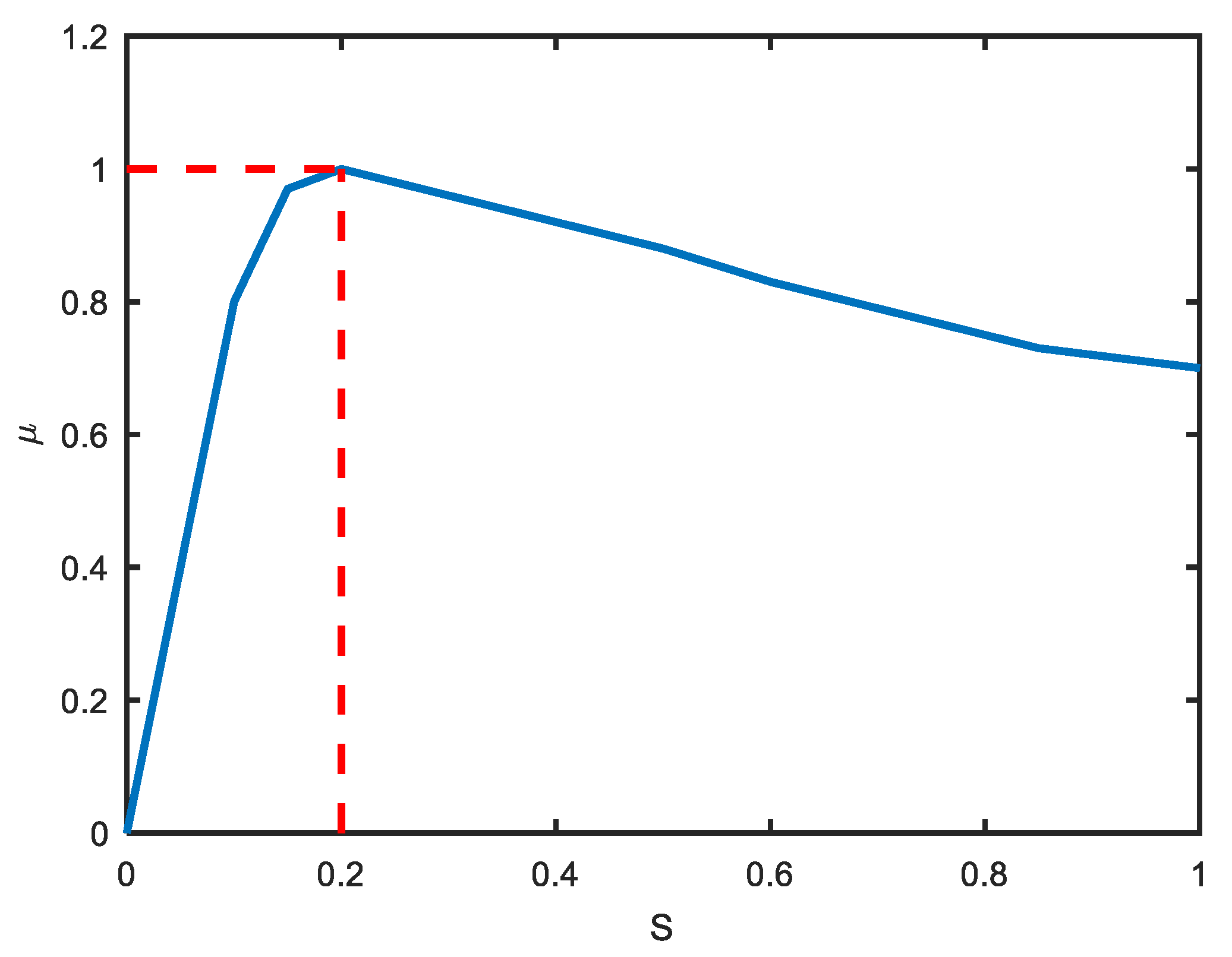
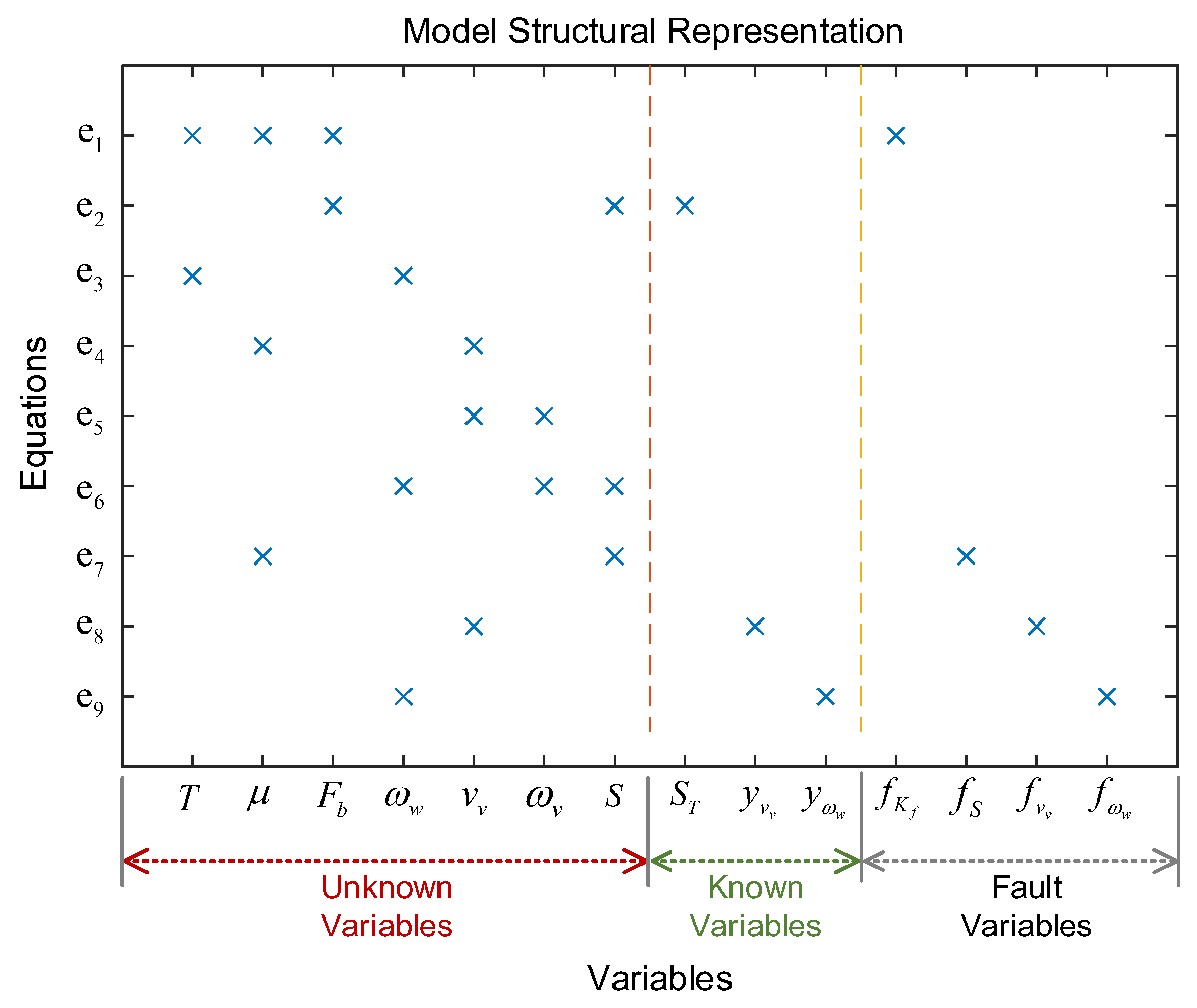

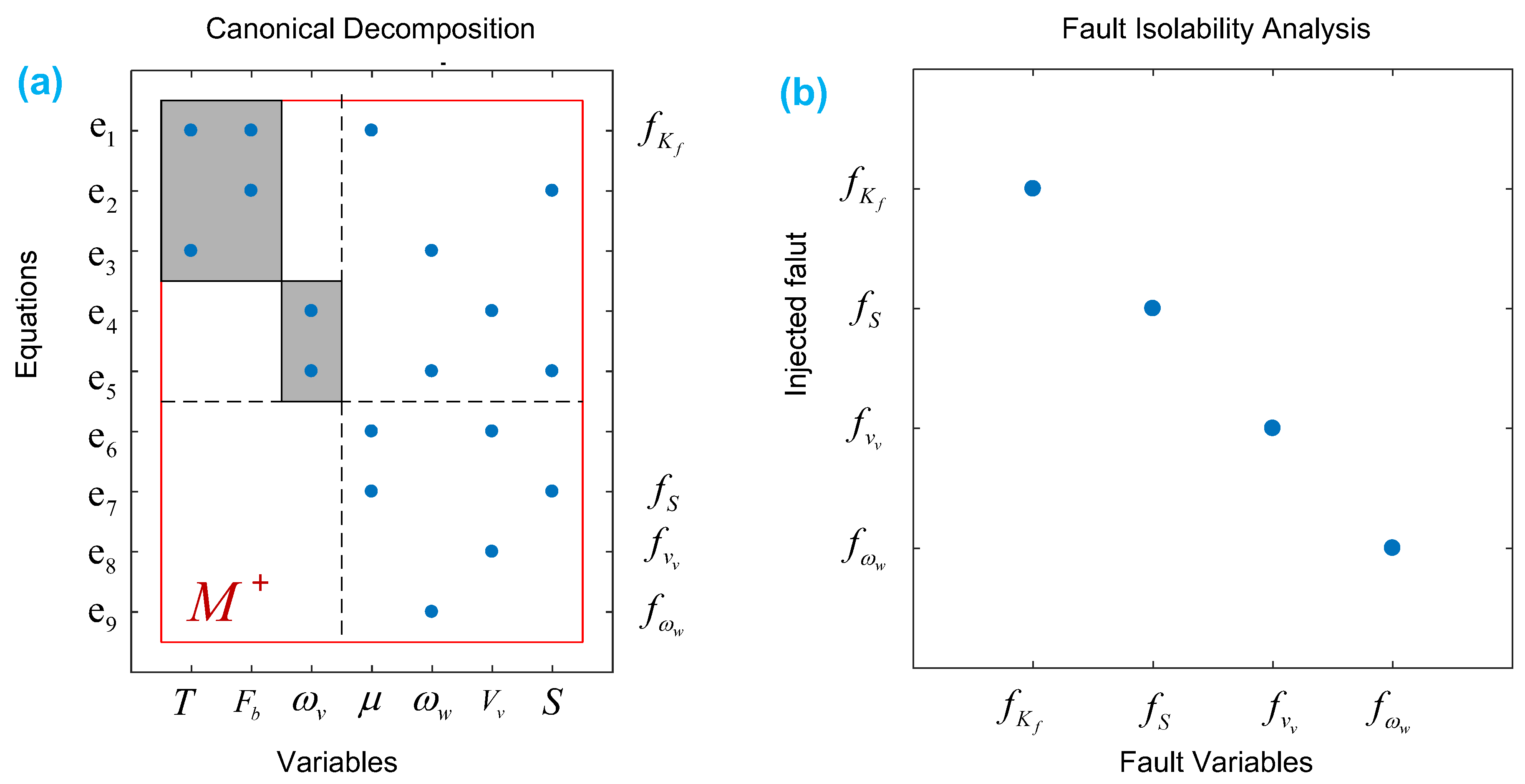
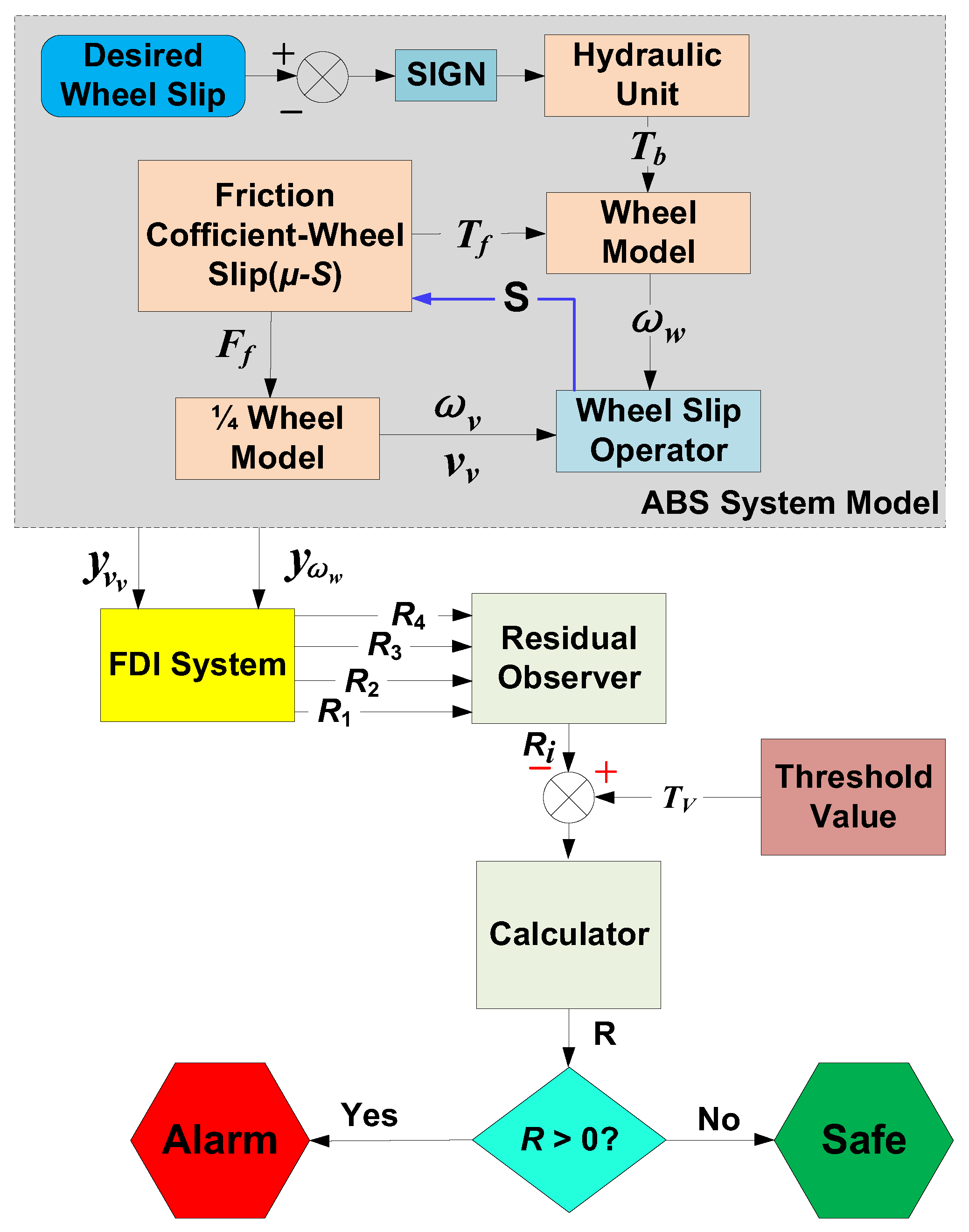

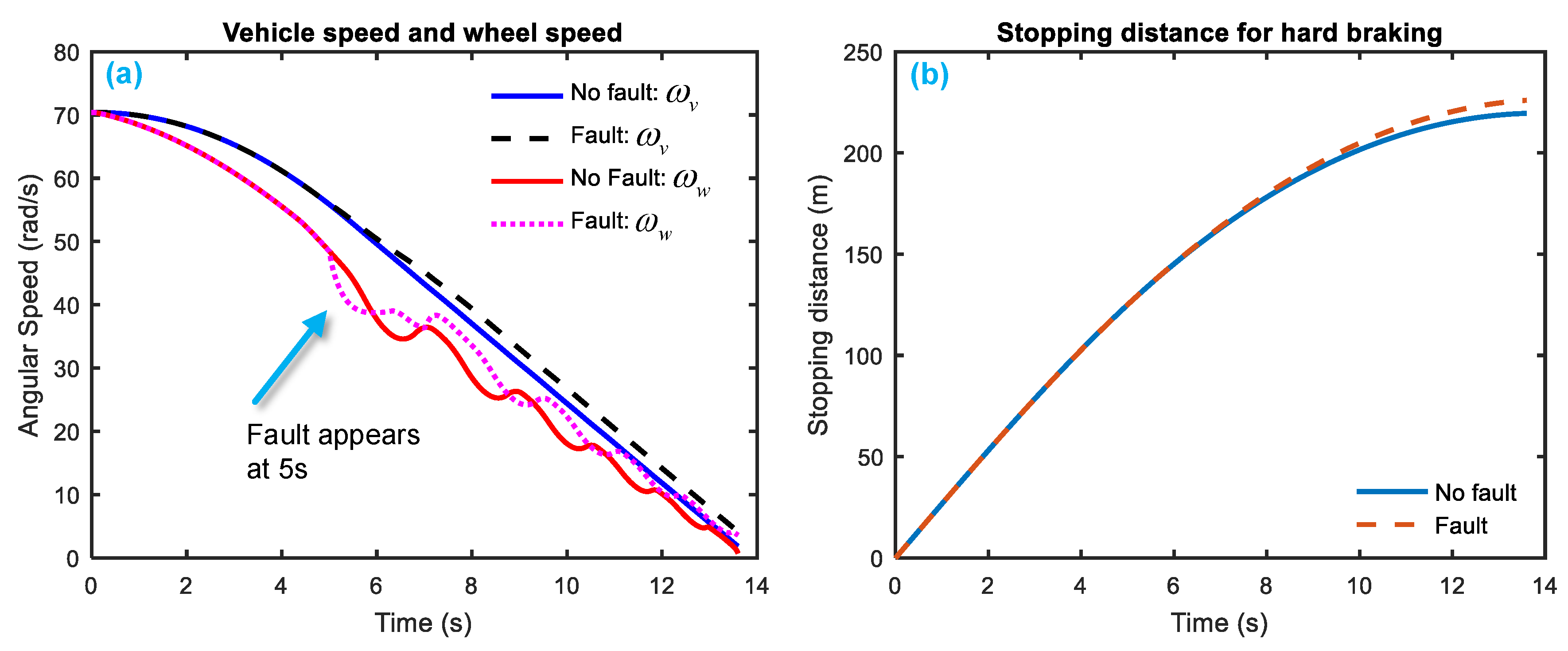

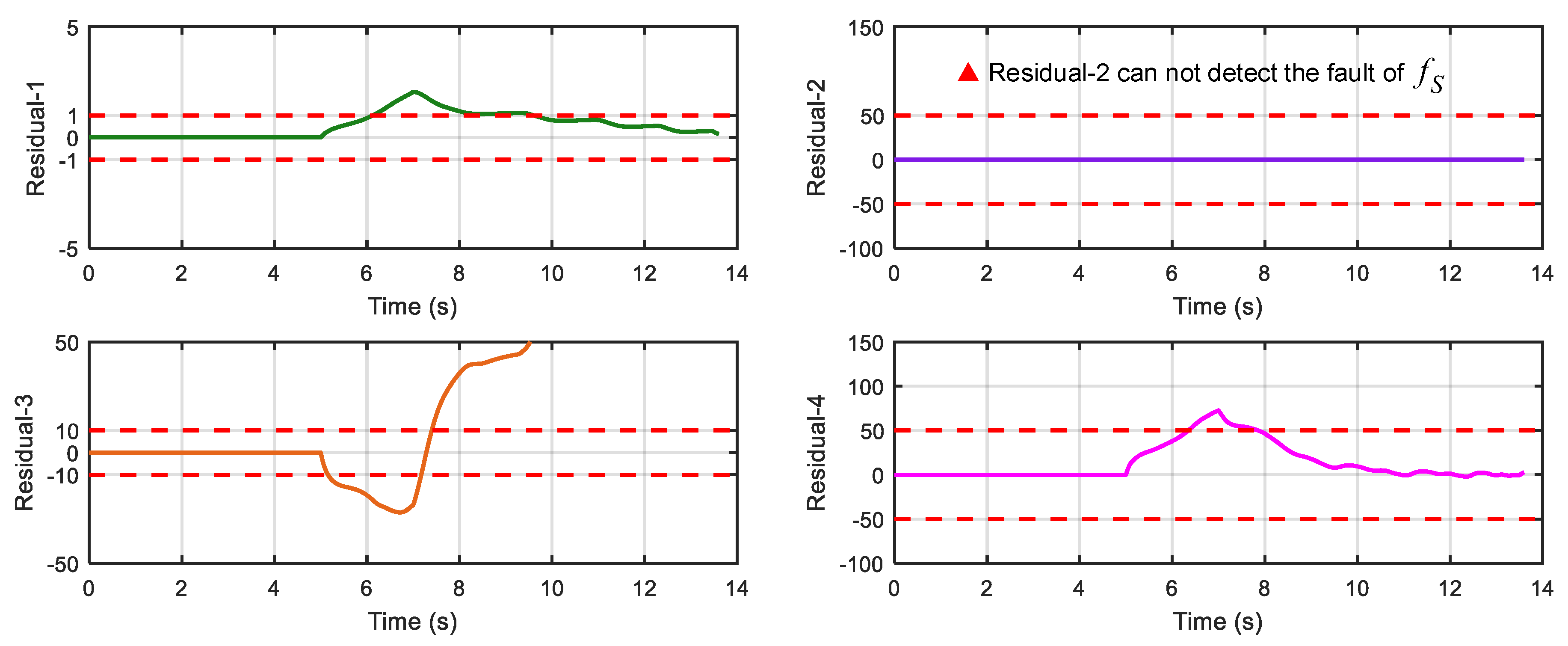
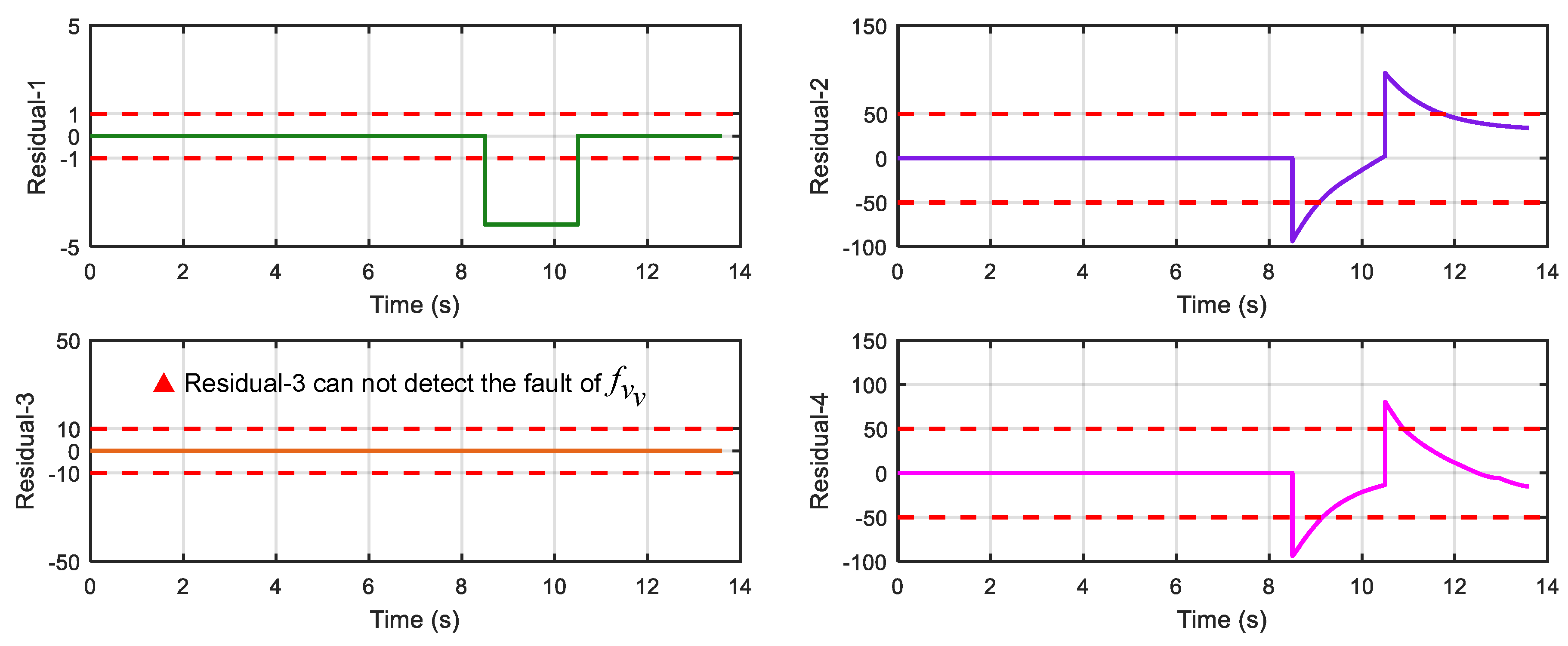
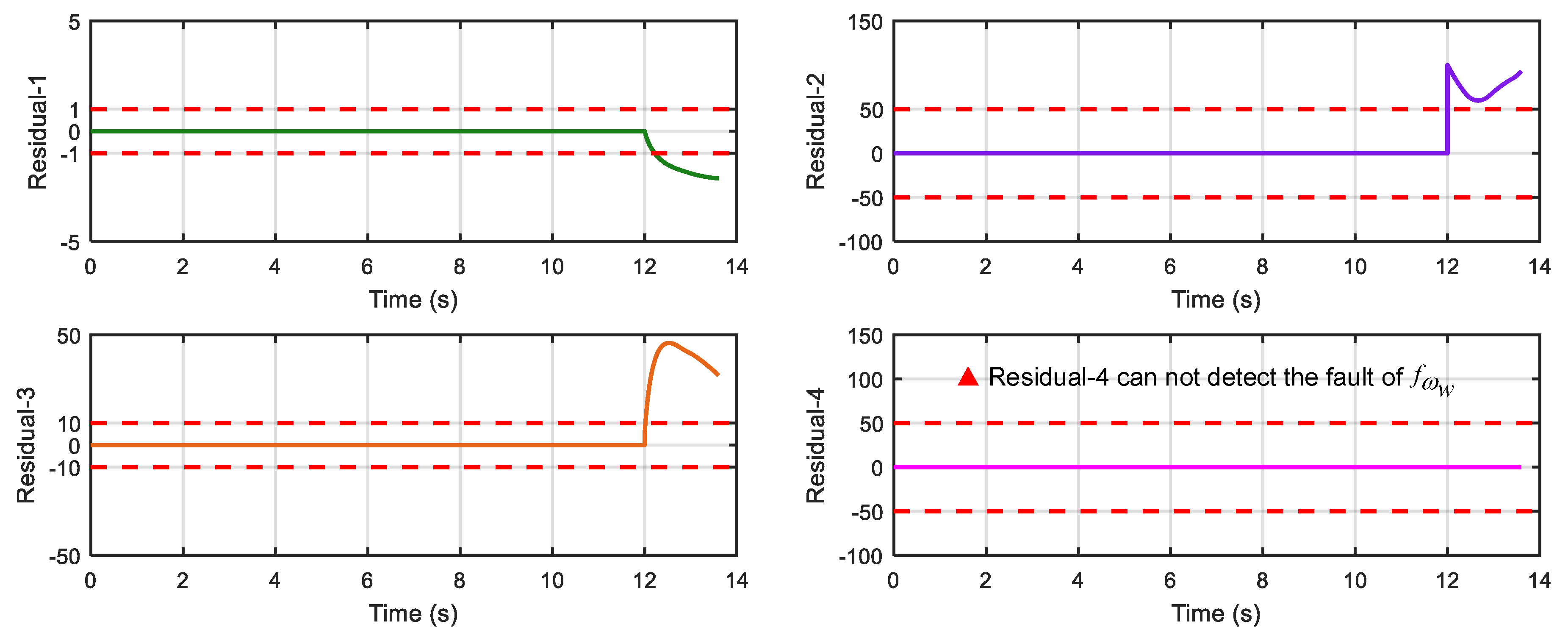
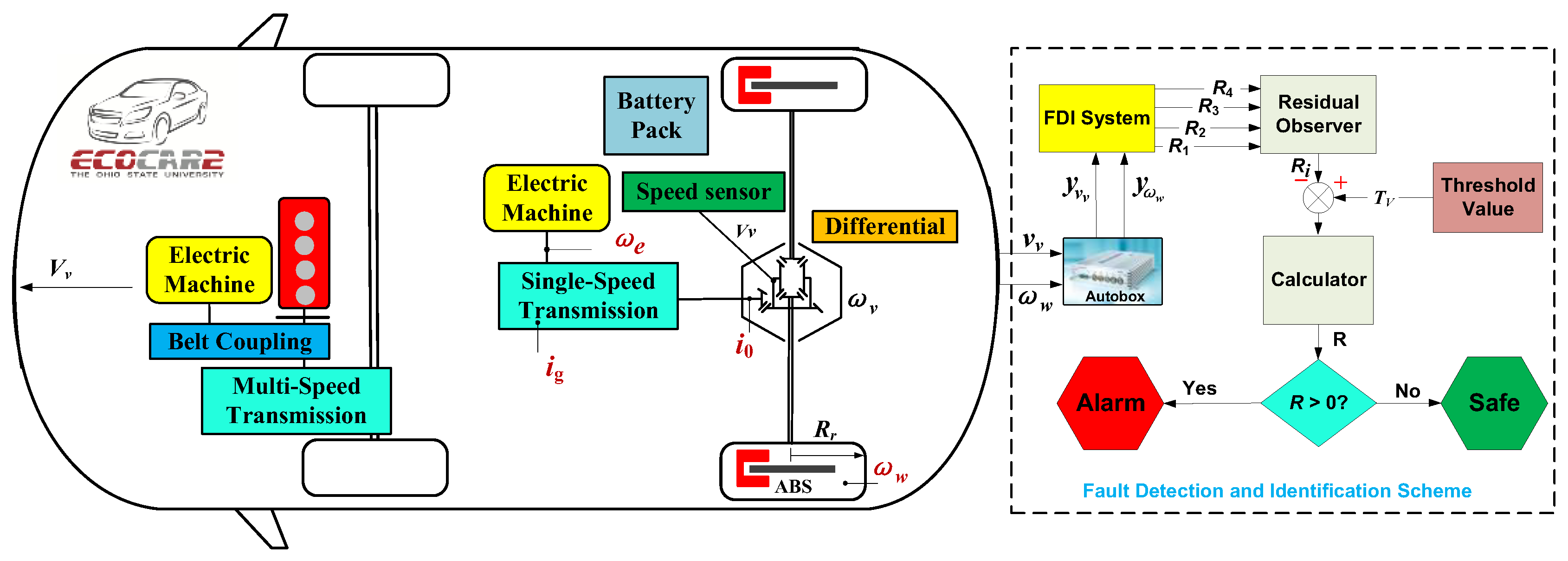

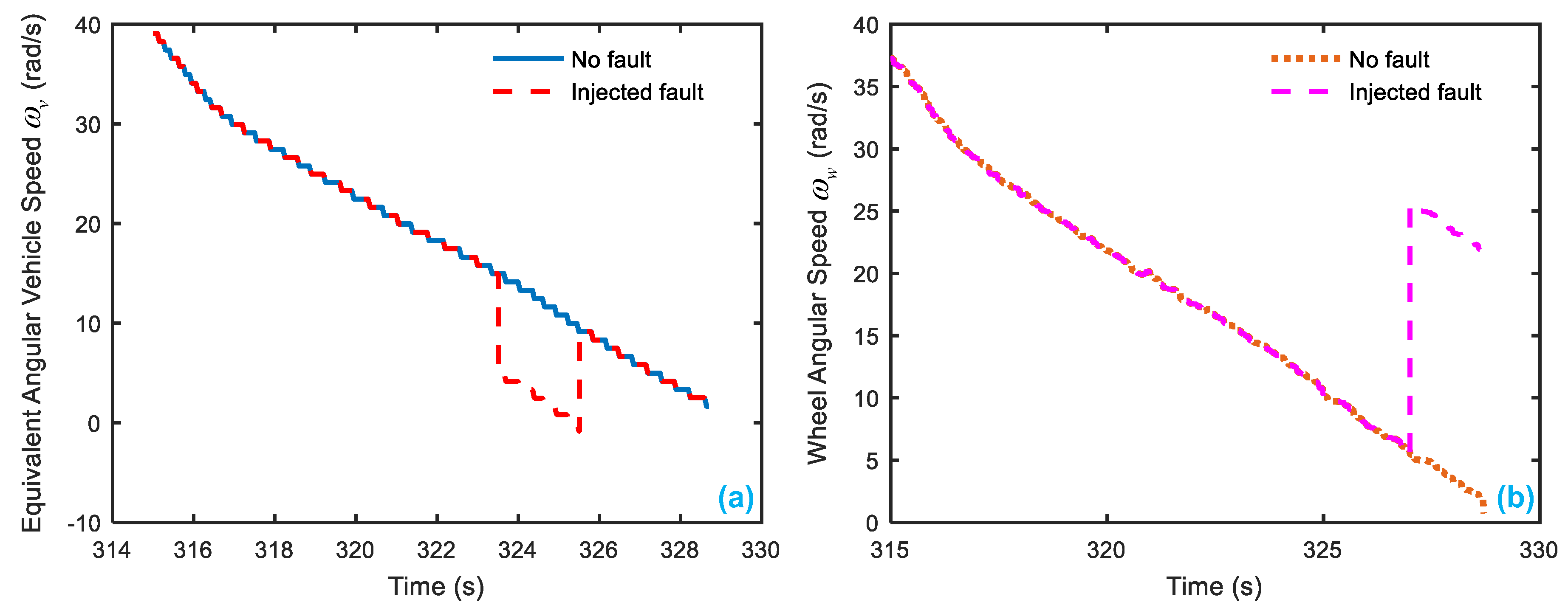
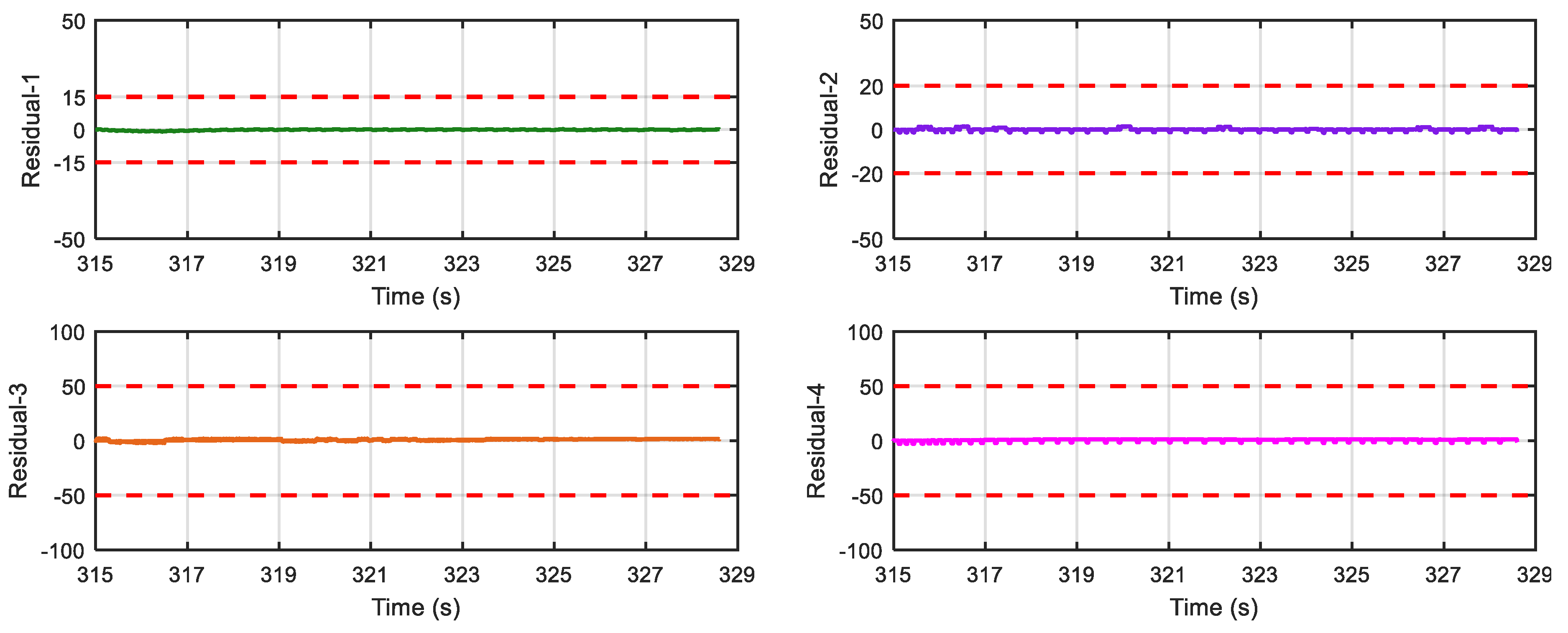

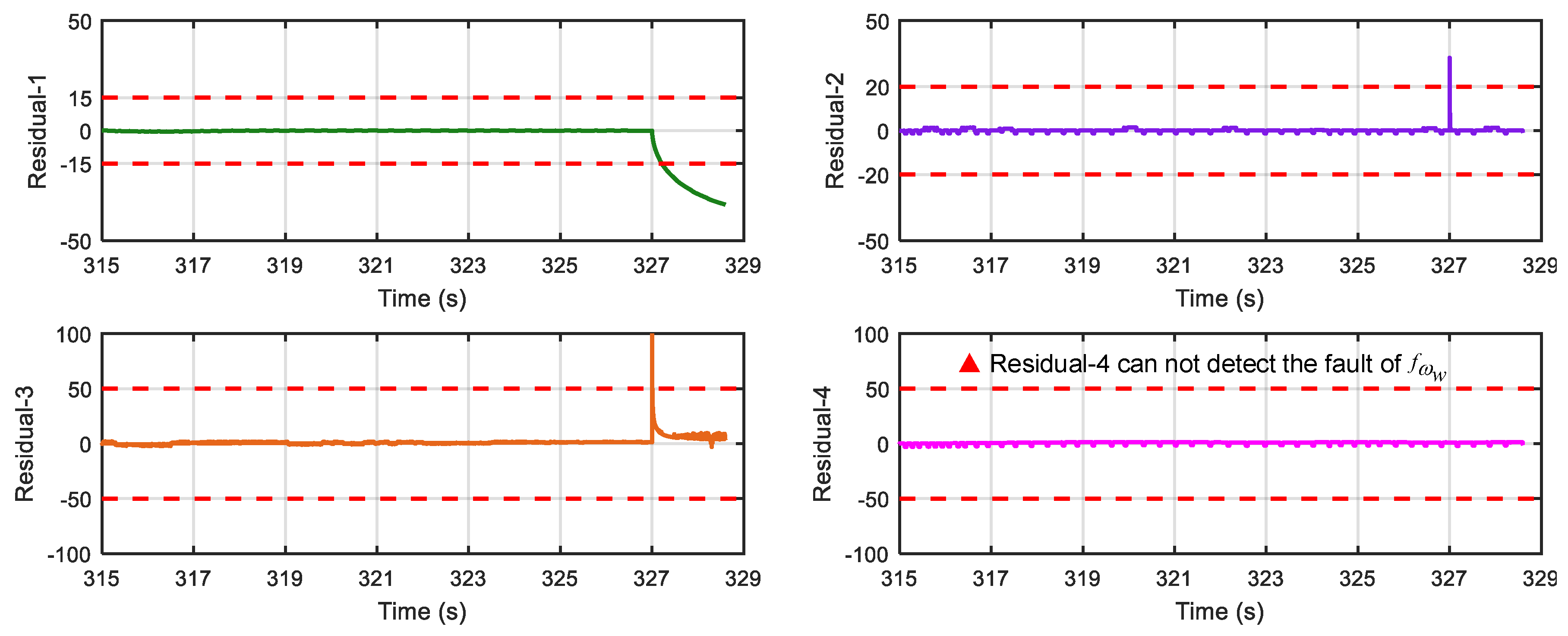
| Faults | Faults Variables |
|---|---|
| Leakage of solenoid value | |
| The fault of slip rate operator/Internal error of ECU | |
| Vehicle speed sensor fault | |
| Wheel angular speed sensor fault |
| Equations | |||||
|---|---|---|---|---|---|
| × | ● | ● | ● | ||
| ● | × | ● | ● | ||
| ● | ● | × | ● | ||
| ● | ● | ● | × |
| Fault | Type | Signal | Time Span |
|---|---|---|---|
| Gain (0.95) |  | ||
| Gain (0.5) |  | ||
| Bias (−10) |  | ||
| Bias (+20) |  | 1214 s |
| × | ● | ● | ● | |
| ● | × | ● | ● | |
| ● | ● | × | ● | |
| ● | ● | ● | × |
| Fault | Type | Signal | Time Span |
|---|---|---|---|
| Bias (−10) |  | ||
| Bias (+20) |  | 327329 |
| Parameter | Values | Unit |
|---|---|---|
| K | 1 | - |
| m | 1897.6 | kg |
| g | 10 | m·s−2 |
| 0.334 | m | |
| 1 | - | |
| 0.01 | - | |
| 0.2 | - | |
| I | 0.735 | kg·m2 |
| 39.09 | rad·s−1 | |
| 10 | - | |
| 30 | - | |
| 20 | - |
© 2018 by the authors. Licensee MDPI, Basel, Switzerland. This article is an open access article distributed under the terms and conditions of the Creative Commons Attribution (CC BY) license (http://creativecommons.org/licenses/by/4.0/).
Share and Cite
Chen, Q.; Tian, W.; Chen, W.; Ahmed, Q.; Wu, Y. Model-Based Fault Diagnosis of an Anti-Lock Braking System via Structural Analysis. Sensors 2018, 18, 4468. https://doi.org/10.3390/s18124468
Chen Q, Tian W, Chen W, Ahmed Q, Wu Y. Model-Based Fault Diagnosis of an Anti-Lock Braking System via Structural Analysis. Sensors. 2018; 18(12):4468. https://doi.org/10.3390/s18124468
Chicago/Turabian StyleChen, Qi, Wenfeng Tian, Wuwei Chen, Qadeer Ahmed, and Yanming Wu. 2018. "Model-Based Fault Diagnosis of an Anti-Lock Braking System via Structural Analysis" Sensors 18, no. 12: 4468. https://doi.org/10.3390/s18124468




